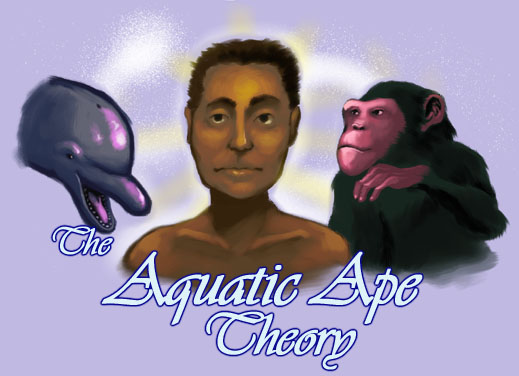 |  | ||||||||||||||||||||||||||||||||||||||||||||||||||||||||||||||||||
 Conventional anthropology states that mankind evolved to his current form after his simian ancestors left the trees, and entered the savannah, where the traits that differentiate us from apes evenutally developed. However, this theory fails to explain the vast majority of the traits that make humans unique among primates. Note the following table:
Table from the Elaine Morgan's AAT Leaflet. Traditional Aquatic Ape Theorists claim that many of these traits that make mankind unique among apes come from a period of water-based evolution that created the several traits which we share with aquatic mammals. What a more profound interpretation of the Aquatic Ape Theory illustrates is that we humans owe our most important traits to a period of evolutionary development that was directly influenced by sea mammals, namely the Sirians. According to the conventional Aquatic Ape Theory, about 5 million years ago, a small group of our ape ancestors found themselves stranded in a flooded area. Isolated in an aquatic environment, evolution was accelerated (much like in the genetically isolated Galapagos Islands), and various developments were made that made our ancestors more well-adapted to their watery world of whimsical wonder. Among these developments was the ability to control breathing. Savannah and other land mammals breathe automatically, just as their heart beats. Only humans and sea mammals have the ability to hold their breath. This trait is key not only in allowing sea mammals and humans to hold their breath underwater, but, more importantly, is a development that was key to humans developing and using language, and therefore culture. Similarly, the sea creatures that our ancestors would have had to eat are rich in Omega-7 fatty acids, which are necessary for the significant brain development they underwent to become homos sapiens. Two of our most important traits as humans, intellect and language, stem from our evolutionary path intersecting that of the cetaceans! Isn't that exciting? Other parallel developments are explained in the above table, except for the habitual bipedalism that apparently only humans have. However, this trait also has aquatic origins. Aquatic mammals, of course, have no legs, and thus would not have developed this. However, when an ape is put in water, the change in weight distribution causes the ape to stand erect! So even our unique stature as humans derives from this period of our evolution. The true nature of man's past as illuminated to us by the Sirians themselves is much more interesting, and lends much more credence to this much criticised theory. Rather than relying on the outlandish notion that such drastic evolutionary changes could occur to our simian ancestors so quickly in nature, it has been revealed that, in fact, our evolution was directly influenced by the Cetacean Sirians. After creating the flooded environment that served to isolate our ancestors, and provide them the shellfish diet they needed for brain development, the Sirians incorporated their DNA into our proto-human ancestors. This allowed us to develop our aquatic traits rapidly, and become homos sapiens as we are today. Even more exciting, it was this occurrence that secured our brotherhood with the Sirians and granted us the extraordinary inheritance that is the 33 Petaled Rose.
It is true that many early human cultures have a Flood myth, in which a divine force from above floods the human world with water, to eliminate the lesser, and preserve a select few. In Gilgamesh and Parallels to the Bible, Linda Casselman notes that So mankind is not simply a highly evolved ape. Man is an Aquatic Ape, who shares an evolutionary past with both Simians and Cetaceans. It is no wonder that both races are concerned with our species's well-being, that we are being presented with a choice from these two peoples. We are a paragon of universal connection and togetherness! The Cetaceans gave us the gifts of language and thought, but truly their greatest gift still waits for our acceptance. The time is now. We must embrace the gift of the 33-Petaled Rose. | |||||||||||||||||||||||||||||||||||||||||||||||||||||||||||||||||||
 |  |